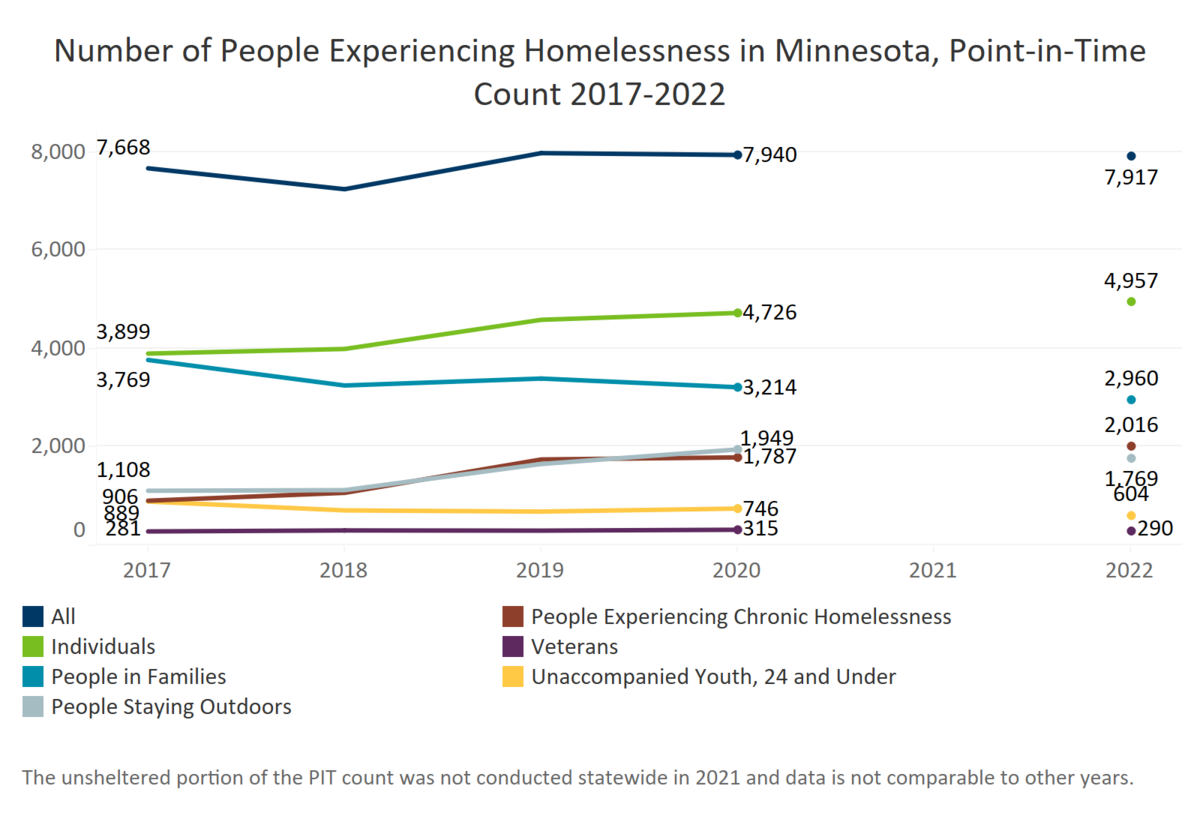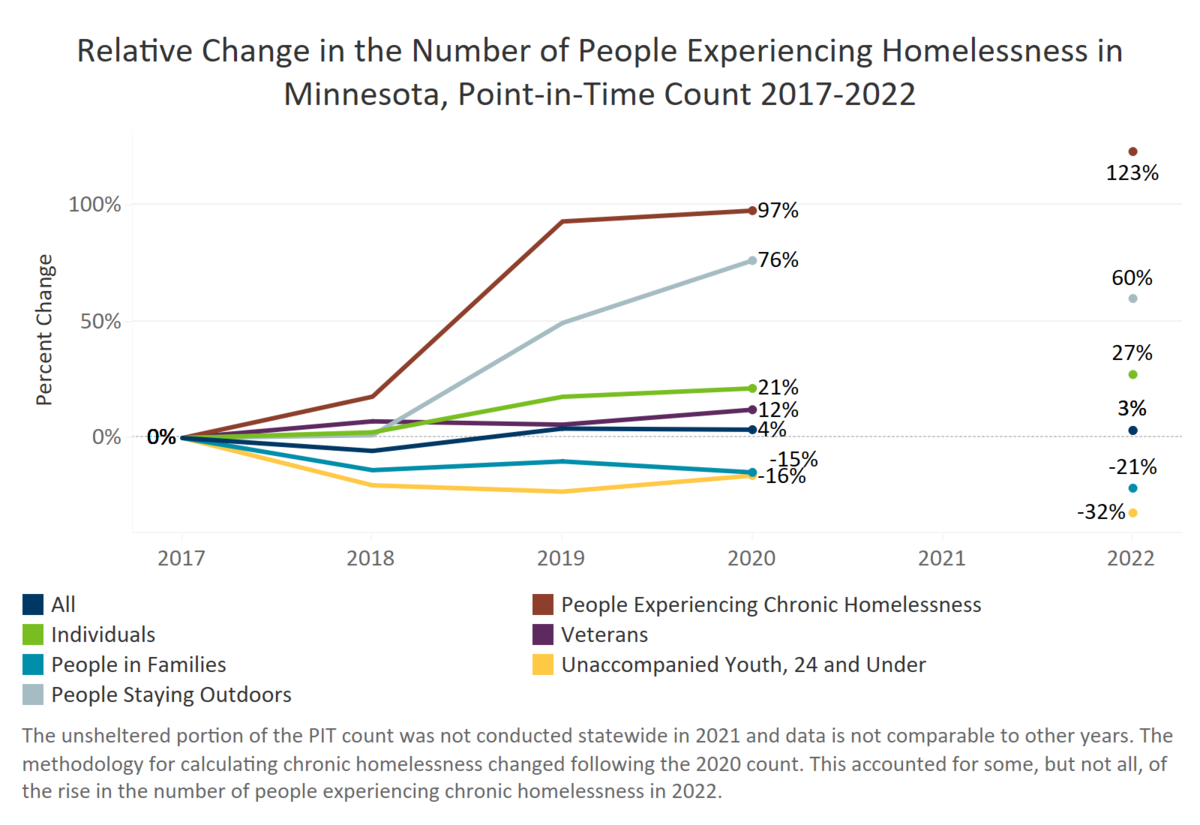Data plays a pivotal role in efforts to identify and develop solutions to prevent and end homelessness in Minnesota. A number of statewide data systems and collection efforts capture information on people experiencing homelessness and this page includes resources on the public data available in Minnesota. It also includes graphics on how different populations are disproportionally impacted by homelessness and key trends in the changing state of homelessness in Minnesota.
Racial and Ethnic Disparities Among People Experiencing Homelessness in Minnesota

This graph depicts the disproportional representation of Black, Indigenous, and People of Color in poverty and homeless populations in Minnesota. Each value represents how likely a specific population is to be in poverty or homeless compared to their white, non-Hispanic counterparts. For example, Native Americans and American Indians are 30 times more likely experiencing homelessness than their white, non-Hispanic counterparts. Populations with a “1” are proportionally represented in poverty or homelessness compared to the general population.
People Experiencing Homelessness in Minnesota, Point-in-Time Count

This graph depicts the number of people experiencing homelessness in the Point-in-Time count between 2017 and 2022. The Point-in-Time Count is an annual count of sheltered and unsheltered people on a single night in January conducted nationwide. The Point-in-Time count does not capture the number of people who experience homelessness throughout an entire year.
Relative Change in Populations of People Experiencing Homelessness in Minnesota, Point-in-Time Count

This graph depicts the relative change in the number of people experiencing homelessness in the Point-in-Time count each year compared to 2017.
HUD’s annual Point-in-Time study
The Point-in-Time count is a nationwide, annual count of sheltered and unsheltered homeless people on a single night in January, facilitated by the United States Department of Housing and Urban Development (HUD). In Minnesota, Continuum of Care (CoC) coordinators, the Institute for Community Alliances (ICA), Tribal nations, service and shelter providers, outreach workers, schools, and volunteers come together to coordinate the PIT count across the state. The Minnesota Interagency Council on Homelessness staff publish a statewide summary of the Point-in-Time Count results each year; data specific to each Continuum of Care region is available from those regions.
More information on the Point-in-Time: https://www.hudexchange.info/programs/hdx/pit-hic/
2024 PIT Council Statewide Summary
2023 PIT Council Statewide Summary
2022 PIT Council Statewide Summary
Wilder Triannual Study on Homelessness in Minnesota
Since 1991, Wilder Research conducts a triannual point-in-time study of people experiencing homelessness across the state. Wilder utilizes face-to-face interviews and a count of individuals living in shelter or experiencing unsheltered homelessness on a single night. The count and face-to-face interviews provide information on the characteristics of people experiencing homelessness, conditions contributing to their homelessness, and the barriers to obtaining safe, stable, and affordable housing. Since 2006, Wilder also conducts a Reservation Homeless Study in partnership with six of Minnesota’s tribal nations. The most recent Minnesota Homeless Study and Reservation Homeless Study occurred in October 2018. Wilder postponed it’s planned 2021 study to October of 2022.
More information on the Wilder study: http://mnhomeless.org/
Minnesota Homeless Management Information System (HMIS) Dashboards:
Statewide, 220 homeless service agencies utilize Minnesota’s Homeless Management Information System (HMIS) to collect client-level data on people experiencing or at-risk of homelessness. State, local, and tribal partners use this data system to connect people experiencing homelessness with housing resources, identify characteristics for people experiencing homelessness, and determine housing outcomes for people accessing homeless services. The Institute for Community Alliances manages Minnesota’s HMIS and publishes data on the people utilizing Minnesota’s HMIS to support communities monitoring progress toward making homelessness rare and non-recurring.
More information on Minnesota’s HMIS Dashboards: https://www.hmismn.org/minnesota-dashboards
MDE Data on Students Experiencing Homelessness
The Minnesota Department of Education (MDE) collects information about students who are homelessness, as defined by the McKinney-Vento Homeless Assistance Act. This definition, individuals who lack a fixed, regular, and adequate nighttime residence, is more expansive than Housing and Urban Development (HUD) definition and includes students who are doubled up. MDE publishes data on the number of students who are experiencing homelessness on October 1st of every school year in their student enrollment reports.
More information on MDE’s enrollment data including the number of students experiencing homelessness: https://public.education.mn.gov/MDEAnalytics/DataTopic.jsp?TOPICID=2
Local Homeless Prevention Aid
Local homeless prevention aid is funding distributed to counties to help local governments ensure no child is homeless within a local jurisdiction by keeping families from losing housing and helping those experiencing homelessness find housing. Learn more about this funding, resources for counties and their partners related to the funding, and recommendations and considerations for maximizing the impact of these dollars on the program page.
The Minnesota Statewide Training Planning Workgroup (comprised of state agency staff, Continuum of Care (CoC) leads, and nonprofit partners from across the state) was formed in 2019 to help identify resources and strategies to better meet the training needs of shelter and housing providers across the state. This page will be built out to include a variety of training topics.
NAEH Center for Learning | Homeless and Housing Resource Center | SHELTER WORKER | STREETWORKS | HOUSING FIRST
Experiencing homelessness or housing instability and you need help?
To find essential services and resources in your community, dial 211, or visit 211.org. Referral specialists can help link or refer you directly to an agency or organization that can help.
Find Additional Resources https://www.mnhousing.gov/housing-help.html
